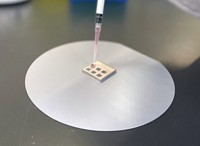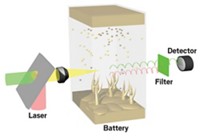Advertisement
Grab your lab coat. Let's get started
Welcome!
Welcome!
Create an account below to get 6 C&EN articles per month, receive newsletters and more - all free.
It seems this is your first time logging in online. Please enter the following information to continue.
As an ACS member you automatically get access to this site. All we need is few more details to create your reading experience.
Not you? Sign in with a different account.
Not you? Sign in with a different account.
ERROR 1
ERROR 1
ERROR 2
ERROR 2
ERROR 2
ERROR 2
ERROR 2
Password and Confirm password must match.
If you have an ACS member number, please enter it here so we can link this account to your membership. (optional)
ERROR 2
ACS values your privacy. By submitting your information, you are gaining access to C&EN and subscribing to our weekly newsletter. We use the information you provide to make your reading experience better, and we will never sell your data to third party members.
Analytical Chemistry
Bioimaging With Mass Spectrometry
High-resolution maps of molecular species distributions are poised to benefit biology, medicine
by Mitch Jacoby
April 3, 2006
| A version of this story appeared in
Volume 84, Issue 14

COVER STORY
Bioimaging With Mass Spectrometry
From Pittcon
Imagine slipping a specimen under the sights of a high-resolution microscope, observing interesting sample features, and then selecting a particular region and instantly learning its chemical composition. Such analytical prowess may sound fanciful. Nonetheless, that type of information is already being derived from some laboratory techniques that combine microscopic imaging with spectroscopic analysis. And new methods along those lines are being developed.
One way to gather and present chemical information about tiny regions of a sample is to use mass spectrometry (MS) to construct maps that pinpoint the distribution of molecular species throughout the sample (C&EN, Nov. 15, 2004, page 33). That technique was the topic of discussion last month at a Pittcon symposium at which researchers presented some of the latest results from methods-development studies and applications to imaging biological materials and interfaces.
Ron M. A. Heeren, an MS group leader at the Institute for Atomic & Molecular Physics, in Amsterdam, kicked off the symposium by reviewing various MS-based imaging methods. He argued that, in general, such techniques boast a number of advantages relative to other imaging methods. "It's a discovery tool, not a method for targeted analysis that requires labeling specific biomolecules," he stressed. As a result, no labeling is necessary and a wide variety of analytes can be probed in their native and unmodified forms. In addition, the method is ideally suited to probing biomolecular reactions that result in mass changes.
Two classes of techniques used by most research groups active in the field are secondary ion mass spectrometry (SIMS) and matrix-assisted laser desorption ionization (MALDI).
In the SIMS method, energetic ions bombard a sample and dislodge analyte ions (the so-called secondary ions), which are ejected toward a mass spectrometer for analysis. In a common variation of the method referred to as matrix-enhanced SIMS (ME-SIMS), the sample is coated with an organic acid or other material to improve ionization efficiency. Similarly, MALDI involves preparing samples in a chemical matrix, but in that technique ionization is mediated by irradiating the sample material with laser light. In both procedures, ions are typically detected by time-of-flight methods.
Heeren noted that the techniques are complementary. SIMS probes samples up to a shallow depth (roughly 100 nm) and can provide nanometer-level lateral resolution. In contrast, MALDI probes samples to a much greater depth and tends to provide lower spatial resolution. Both methods are effective at desorbing intact biomolecules, which is a key requirement for many imaging studies. But in terms of the mass range of analytes that can be probed, SIMS is more limited than MALDI, which, for example, is capable of analyzing large intact proteins.
Hereen explained that chemical images can be constructed by rastering (scanning) a pulsed beam across a sample and building up two-dimensional pictures through a series of position-correlated spectra. Alternatively, the images can be prepared by irradiating a large portion of a sample with a pulsed beam, collecting the ions in a way that retains their spatial distribution, and detecting the analytes with a position-sensitive detector.
In a recent application of their ME-SIMS method, Heeren and coworkers imaged samples of brain tissue collected from freshwater snails (Lymnaea stagnalis). The team's tissue images resemble conventional micrographs that reveal micrometer-sized subcellular structures with selectively stained regions. Heeren explained that the MS image, which is a mosaic of images from adjacent regions in the sample, was constructed by overlaying a colored distribution map of an endogenous neuropeptide (APGW amide) on top of a map of all the ions collected from the tissue surface. The data show in pictorial form the localization of the peptide within individual cells.
A variation of the SIMS method calls for coating a sample with a thin layer of gold or other metals to enhance ionization and hence boost the analytical signal. The metal-assisted SIMS technique provides imaging benefits similar to those associated with the matrix methods, Heeren noted. His research group showed that the new procedure could be used to prepare MS micrographs with fine spatial and chemical resolution.
For example, in the brain tissue study, Heeren showed that two molecular species with similar mass/charge ratios occur in distinct regions of the brain. The signal from mass/charge ratio 369, which Heeren noted corresponds to dehydroxylated cholesterol, originates from the so-called commissure region, whereas the as-yet-unidentified analyte with mass/charge ratio 365 is primarily confined to a brain structure known as the dorsal body. Likewise, Heeren showed that distinct signals from cholesterol in its dehydroxylated and deprotonated forms can be used to distinguish between glial cells in the brain, which are associated with dehydroxylated cholesterol, and surrounding tissue.
The imaging technique also is attracting the attention of researchers who focus on clinical applications. Richard M. Caprioli views MS-based imaging as a tool with the potential "to bring new dimensions to clinical chemistry and eventually to the way in which physicians treat patients." Caprioli, a biochemistry professor and director of the Mass Spectrometry Research Center at Vanderbilt University, emphasized that the key to realizing that potential lies in using the imaging techniques to help identify the stage of a patient's disease and predict its course.
Working closely with medical researchers, Caprioli's group developed a MALDI-based procedure for deriving molecular signatures from the same microscopic regions of human breast tumor samples that a pathologist had identified earlier via histological methods as either relatively benign or malignant. Caprioli noted that the method revealed that several of the tissue features identified histologically as relatively benign in fact had molecular signatures indicative of invasive forms of cancer.
Similarly, in studies of soft tissue sarcoma (tumor) samples, chemical imaging showed that in some cases, the disease had infiltrated the tissue surrounding the tumor to a much greater extent than was recognized through conventional pathology methods. "It's an exciting development," Caprioli remarked, "because these methods will significantly enhance prognostic [predictive] medicine in pathology."

Back in the mass spec lab, Pennsylvania State University chemistry professor Nicholas Winograd recently began conducting SIMS experiments using energetic C60 projectiles to bombard sample surfaces. Demonstrating the method's fine spatial resolution, Winograd displayed SIMS images of macrophage and astrocyte cells that reveal distinct micrometer-scale cellular features and analyte distributions.
Winograd noted that initial results show a large enhancement in desorbed ion yields (and hence an increase in sensitivity) relative to bombardment with other cluster projectiles such as Au2 and Au3. On the basis of recent experiments, he proposed that sandblasting an organic film with buckyballs liberates protons, which may accumulate in the impact crater and attach to sputtered species, thereby forming protonated molecular ions.
Reporting on computer simulations carried out in collaboration with Penn State chemistry professor Barbara J. Garrison's research group, Winograd pointed out that unlike small cluster projectiles, which penetrate deep into a sample, C60 ions that are equivalent in energy to the smaller clusters hardly reach below the surface. That property may enable layers of a sample to be removed sequentially, which, in turn, could enable researchers to conduct molecular depth profiling and ultimately three-dimensional molecular imaging, Winograd said.
Demonstrating the basis of the measurement, the Penn State team coated a silicon wafer with a sugar solution containing a peptide and then conducted a SIMS experiment. The data show steady-state signals for the sugar and peptide as the film was gradually eroded by the C60 beam. Eventually, the film was removed, and a signal from the silicon support was detected. Winograd explained that if a small cluster or atomic ion had been used instead of C60 ions, the projectiles would have quickly drilled a hole through the peptide film and provided little or no information about the biomolecule.
MORE ON THIS STORY
- Better Than Ever At Pittcon 2006
- Pittcon, Other Trade Shows May Be Declining In Importance For Small Firms
- Shimadzu Exhibits 50-Year-Old Gas Chromatograph At Pittcon
- Analyzing Vaccines
- Bioimaging With Mass Spectrometry
- Private Eye In The Lab
- Multitasking Cells
- Building Bridges
- Chinese Instrument Market Warms Up
- New & Notable At Pittcon 2006
"Biological samples are complicated materials," Winograd summarized. "The ability to image them with high resolution and simultaneously analyze them chemically is a very intriguing prospect that is already leading to exciting breakthroughs."








Join the conversation
Contact the reporter
Submit a Letter to the Editor for publication
Engage with us on Twitter